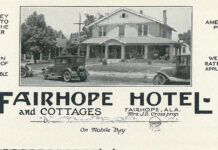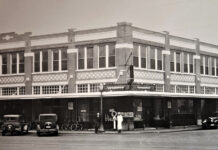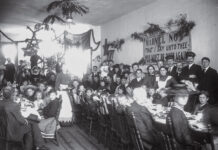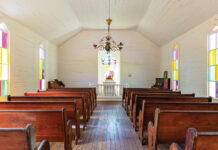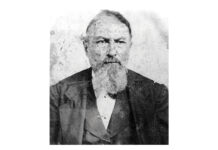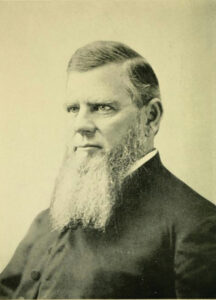
Portrait of Bishop Richard Hooker Wilmer.
In 1894, a post office was established on the westernmost edge of Mobile County and named for the second Episcopal bishop of Alabama, Richard Hooker Wilmer (1816-1900). It is unclear what association the bishop had with that area since he had been a resident of Spring Hill for some 30 years at that point. That community would officially become a “city” in 1970 and vote to unincorporate in 1993 after earning the reputation of being one of the worst speed traps in the history of our state.
The name of the bishop in Mobile is better known for the orphan’s home he established in 1864 in Tuscaloosa. Two years later, that institution moved to South Warren Street in Mobile near St. John’s Episcopal Church.
Bishop Wilmer was a Virginian by birth and his father had the distinction of serving as the president of the College of William and Mary in Williamsburg. After his graduation from Yale in 1836, he received a theological degree in 1839. The following year, he became an Episcopal priest and served a number of Virginia parishes where he received an excellent reputation as both a preacher and church leader. He reportedly had that rare ability to never forget a face or a name and addressed half his congregation by their first name.
A biographer who knew Bishop Wilmer would later describe him as “an orator, wit, theologian and Prince of the Church. He was six feet tall, chest broad and deep, thick brown hair, clear blue eyes sparkling with humor, beaming with benevolence and firing with indignation.”
Military Order 38
On November 21, 1861, he was elected bishop of Alabama. As the South had already seceded and the Episcopal Church had split, he would be reelected by the combined church after the conflict had ended. During the early days of Reconstruction in June of 1865, Wilmer issued an order removing the standard “Prayer for All of Those in Civil Authority” from the state’s Episcopal church services.
Wilmer explained that he could not conscientiously pray for military rulers and would resume the phrase when Alabama was returned to civil authority. Quite ironically, it was another native of Virginia, Union General George H. Thomas, who was so incensed by the omission that he closed down all of the Episcopal churches in Alabama and had the doors guarded by his soldiers in blue. That official dictum was known as Military Order 38.
The bishop steadfastly held his ground with the position that it was not the government’s place to be telling any church for whom they should pray. Finally, early in 1866, President Andrew Johnson had to intervene, citing the First Amendment. Thomas’ unpopular order was rescinded, services resumed and Wilmer put the traditional prayer back in place.
The Orphanage
It was also during this period that Wilmer sought funds for the orphanage in Mobile. He traveled to New York and attended a dinner with 15 prominent men in the hopes of raising needed funds. During the meal, the men constantly teased him, calling him the “Rebel Bishop.”
Finally, Wilmer had enough and asked the group, “Why are Southerners like Lazarus?” They laughingly answered, “Because you are sore.” The bishop responded, “No, because we were licked by dogs.” The next day, that group of men had contributed $100 each for a total of $1,500 — a sum equal to $30,000 today.
By the autumn of 1866, a small-frame building had been constructed on South Warren Street at a cost of about $1,000. Fairs were held which netted $3,000, allowing a schoolhouse to be built next. And, in 1868, some $4,600 more was raised, permitting the construction of an infirmary, kitchen and laundry.
Although Wilmer was greatly interested in the development of the orphanage near Downtown, he and his wife resided on Old Shell Road in Spring Hill, just east of St. Paul’s Episcopal Church. Their home was never owned by the church, however. It had been given to them by friends. The property consisted of a raised cottage with wings to the sides set among extensive gardens.
When his travels and duties as a bishop allowed, he conducted services at St. Paul’s Church, which had been completed in 1859.
Spring Hill Seclusion
Spring Hill in the last quarter of the 19th century was accessible by horse or a mule-drawn trolley assisted by oxen when they reached the hill. When asked why he preferred such a relatively secluded location, he would respond, “If a visitor has anything worth talking about, they will not object to 14 miles of street-car travel. My seclusion sifts out the unimportant, unnecessary, time-wasting visitor.” To those who took the time to visit, he was always welcoming and enjoyed long conversations.
In 1896, coinciding with his 80th birthday, the endowment for the orphanage he had established reached $40,000. He died four years later and is buried in Mobile’s Magnolia Cemetery.
In 1915, the Church Home moved to a 10-acre site in Spring Hill east of the Wilmer house, but it would not be renamed to honor the bishop until 1948. An apartment complex was later built where the Wilmer home once stood. mb

